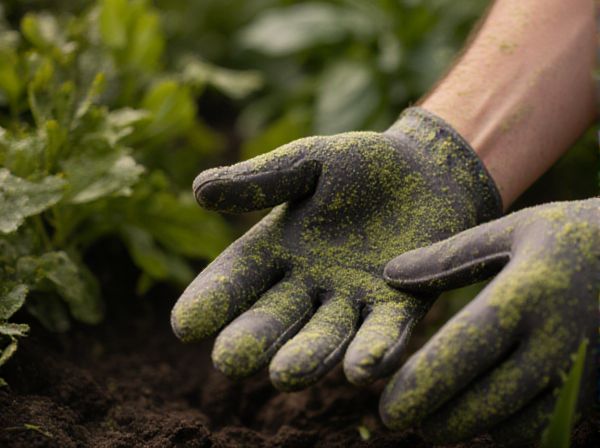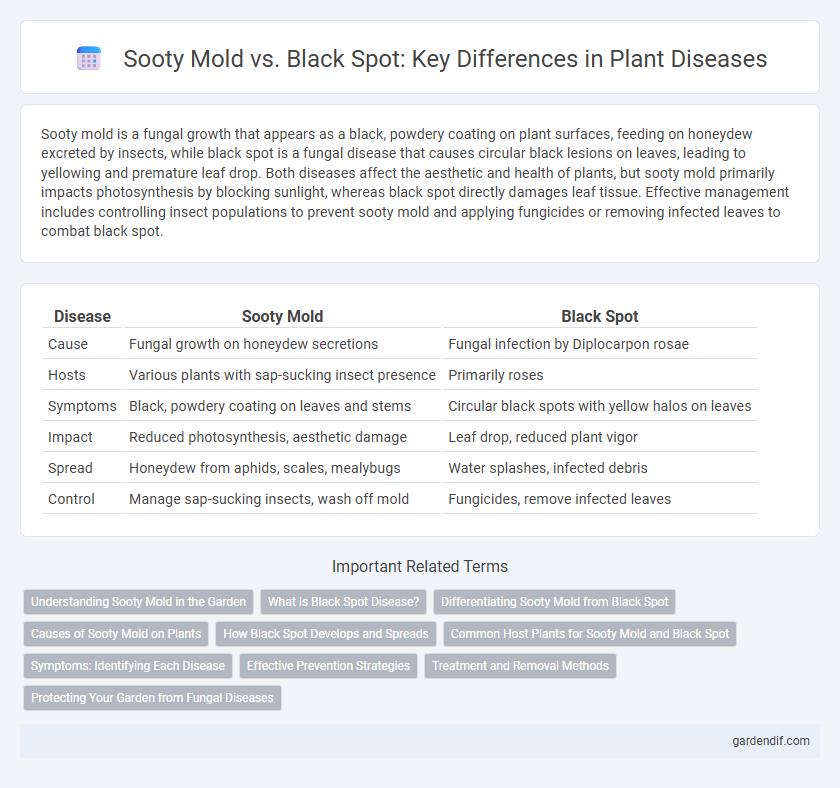
Sooty mold vs Black spot Illustration
Sooty mold is a fungal growth that appears as a black, powdery coating on plant surfaces, feeding on honeydew excreted by insects, while black spot is a fungal disease that causes circular black lesions on leaves, leading to yellowing and premature leaf drop. Both diseases affect the aesthetic and health of plants, but sooty mold primarily impacts photosynthesis by blocking sunlight, whereas black spot directly damages leaf tissue. Effective management includes controlling insect populations to prevent sooty mold and applying fungicides or removing infected leaves to combat black spot.
Table of Comparison
| Disease | Sooty Mold | Black Spot |
|---|---|---|
| Cause | Fungal growth on honeydew secretions | Fungal infection by Diplocarpon rosae |
| Hosts | Various plants with sap-sucking insect presence | Primarily roses |
| Symptoms | Black, powdery coating on leaves and stems | Circular black spots with yellow halos on leaves |
| Impact | Reduced photosynthesis, aesthetic damage | Leaf drop, reduced plant vigor |
| Spread | Honeydew from aphids, scales, mealybugs | Water splashes, infected debris |
| Control | Manage sap-sucking insects, wash off mold | Fungicides, remove infected leaves |
Understanding Sooty Mold in the Garden
Sooty mold is a fungal growth that appears as a black, powdery coating on leaves and stems, often developing on honeydew secreted by sap-sucking insects like aphids or whiteflies. Unlike black spot, which directly infects plant tissue causing circular lesions and defoliation, sooty mold primarily affects the plant's ability to photosynthesize by blocking sunlight absorption. Managing sooty mold involves controlling the insect population to reduce honeydew production and promoting good air circulation to discourage fungal growth.
What Is Black Spot Disease?
Black spot disease is a fungal infection caused by the pathogen Diplocarpon rosae, primarily affecting rose plants. It manifests as circular black spots with fringed edges on leaves, leading to yellowing and premature leaf drop. This disease significantly weakens the plant by disrupting photosynthesis and can reduce flowering if not properly managed.
Differentiating Sooty Mold from Black Spot
Sooty mold manifests as a dark, powdery coating on plant surfaces, growing primarily on honeydew secreted by pests like aphids, whereas black spot presents as circular black lesions with fringed edges on leaves. Sooty mold does not directly infect plant tissues, but black spot is a fungal disease caused by Diplocarpon rosae that damages leaves and reduces photosynthesis. Identifying honeydew presence and the location of symptoms--surface coating versus leaf spots--helps differentiate sooty mold from black spot disease.
Causes of Sooty Mold on Plants
Sooty mold on plants is primarily caused by the growth of fungi in the order Capnodiales, which thrive on the honeydew secreted by sap-sucking insects such as aphids, whiteflies, and scale insects. This black, powdery fungal coating does not directly infect plant tissues but develops on the sugary excretions left on leaves and stems. The presence of sooty mold indicates an underlying insect infestation that promotes fungal colonization and reduces photosynthesis by blocking sunlight.
How Black Spot Develops and Spreads
Black spot develops when the fungal pathogen *Diplocarpon rosae* infects rose leaves, stems, and petals under warm, wet conditions, typically between 65degF and 80degF with prolonged leaf wetness. The fungus produces black lesions with fringed edges that gradually expand, causing defoliation and weakening the plant's overall health. Spores spread through water splash, wind, and infected plant debris, promoting rapid transmission during rainy or humid weather.
Common Host Plants for Sooty Mold and Black Spot
Common host plants for sooty mold include citrus trees, hibiscus, and tomatoes, where the fungus thrives on honeydew secreted by sap-sucking insects. Black spot predominantly affects roses, causing significant leaf damage and defoliation. Both diseases can also appear on various ornamental plants, necessitating targeted management strategies to protect susceptible species.
Symptoms: Identifying Each Disease
Sooty mold appears as a thick, black coating on leaf surfaces, often associated with honeydew secretions from insects like aphids or whiteflies, causing a dusty, soot-like appearance that obstructs photosynthesis. Black spot presents as distinct circular black lesions with fringed edges on the upper leaf surface, frequently accompanied by yellowing areas around the spots, leading to premature leaf drop. Differentiating these symptoms is crucial for effective disease management and accurate treatment strategies in affected plants.
Effective Prevention Strategies
Sooty mold prevention relies on controlling the sap-feeding insects such as aphids, whiteflies, and scale that produce honeydew, which fosters mold growth. Black spot management involves consistent application of fungicides containing neem oil or chlorothalonil, combined with proper pruning to improve air circulation and reduce leaf moisture. Implementing integrated pest management by monitoring pest populations and maintaining plant health through balanced fertilization also enhances resistance against both diseases.
Treatment and Removal Methods
Sooty mold is primarily treated by controlling the insect pests like aphids or whiteflies that produce honeydew, using insecticidal soaps or neem oil to reduce mold growth. Black spot disease requires fungicidal sprays containing chlorothalonil or sulfur applied early and repeated regularly for effective control. Removing infected leaves and improving air circulation around plants can prevent both diseases from spreading.
Protecting Your Garden from Fungal Diseases
Sooty mold and black spot are common fungal diseases that threaten garden health by damaging leaves and reducing photosynthesis. Sooty mold thrives on honeydew secreted by insects, needing effective pest management to prevent its growth, while black spot requires regular pruning and fungicidal treatments to control its spread on roses and other susceptible plants. Protecting your garden involves monitoring plant health, ensuring proper air circulation, and using targeted treatments to reduce fungal infection risks.
Sooty mold vs Black spot Infographic

 gardendif.com
gardendif.com